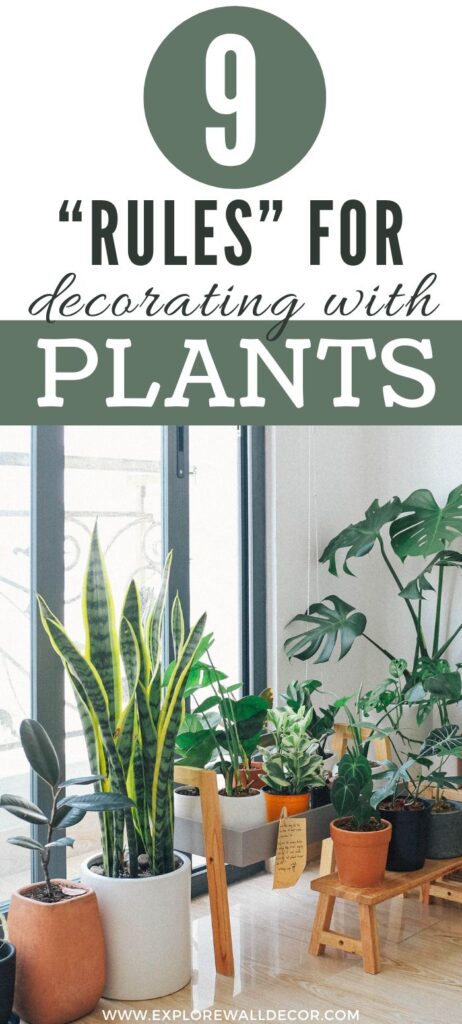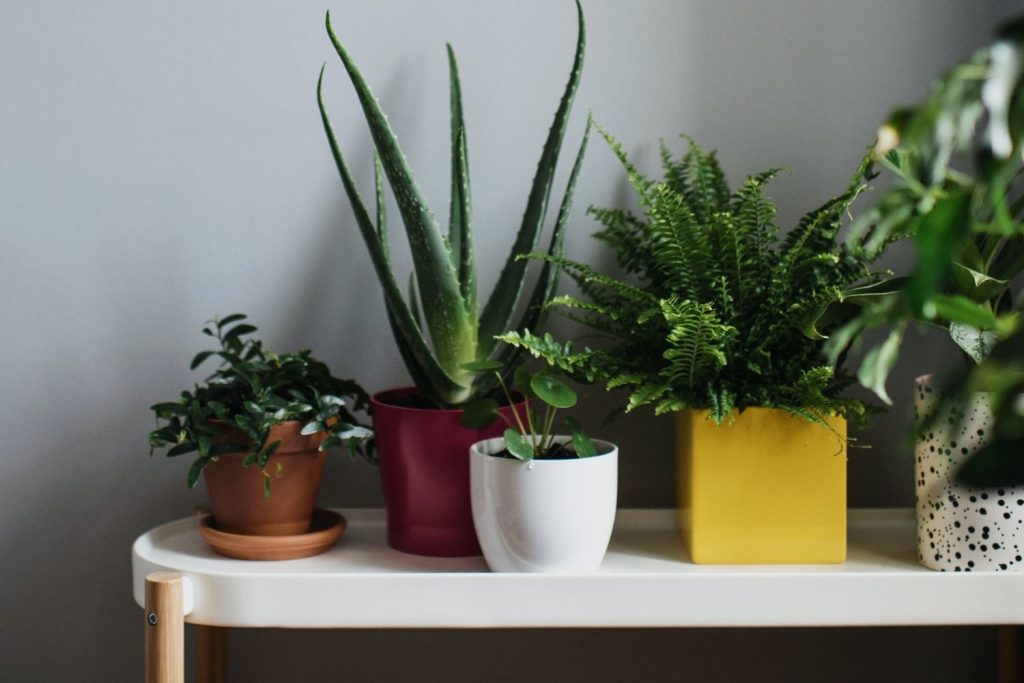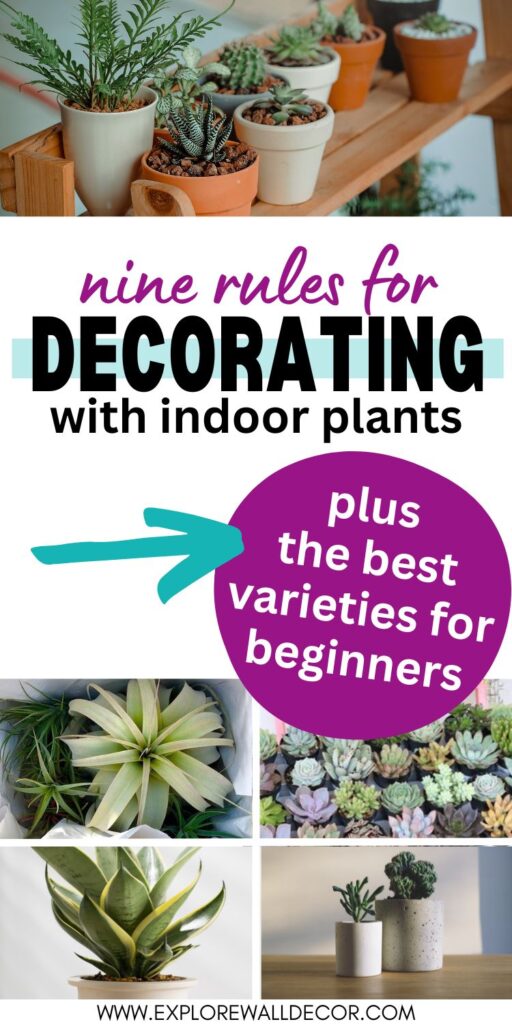Adding greenery to your home decor will instantly liven it up, so today we’re bringing you nine need-to-know rules for decorating with plants.
Don’t worry — even if you’re a complete newbie to plants, you can still decorate your home with them. (And if you stick with me till the end, I’ll be sharing a few recommendations for beginners.)
In addition to giving your space a pleasing aesthetic, live plants provide oxygen and rid the house of toxins. However, there are a few things you’ll want to know before getting started with your plant decor.
While this article is geared toward decorating your interior space with real live plants, many of these rules still apply to decorating with faux plants. (And yes, that’s totally okay, as long as they are good quality fakes!)
Let’s jump in and go over those nine rules for decorating the house with plants — and then we’ll move on to my recommendations for new plant parents.

This post may contain affiliate links and we may earn commissions when you click on the links at no additional cost to you. See our disclosure policy for more details.
Rules for Decorating With Plants
Ready to get started? Here are nine things you need to know about adding plants to your home decor.
Rule #1: Get Them Off the Floor

With the exception of taller plants and trees, as well as those in bigger pots, your plants don’t want to live on the floor. Get them up off the ground, where you can really enjoy them, and they will start to thrive!
A few decorative ideas to bring them upward:
- Hang them from the ceiling with a macrame plant hanger (this is the perfect solution for pet parents!).
- Set smaller plants, like succulents, on a floating shelf.
- Small plants also work well in little wall planters like these.
- Buy a plant stand or a little stool to set your plant on.
- Place them on your larger furniture, like a bench, dresser, or credenza.
- Create an indoor garden on top of a bar cart.
- Boost up a smaller plant by setting it on top of a stack of books.
Why keep plants on the floor, where no one can see them? Raise them up to eye level, and you’ll bring more enjoyment to everyone’s life.
Rule #2: Keep Scale in Mind

What does this mean, exactly? Scale simply refers to the way an object’s size relates to the size of the objects around it, along with the room’s size.
“Proportion” is a related term, but refers to the size relationship between two objects.
As you might imagine, putting a huge plant in a tiny powder room would feel overwhelming (and you obviously wouldn’t place it on top of a smaller piece of furniture). Likewise, a single succulent would look pretty lonely by itself on a large shelf.
Those are pretty extreme examples, but I wanted to paint a clear picture for you. Some situations might not be as obvious, but my point is to use a critical eye and keep scale in mind when decorating with plants.
Rule #3: Coordinate the Pot Colors

Coordinating pot colors does NOT necessarily mean you have to get all matchy-matchy. You can absolutely mix them up! Truthfully, it will be much more interesting that way, anyway.
BUT…
Coordinating container colors only means that the hues you choose should complement one another.
For example, gray and brown don’t typically look great together. On the other hand, you might be able to mix blue and orange, since they are complementary colors.
A few ideas for coordinating your plant containers:
- Choose a few pots that are the same color, but get it in several different sizes.
- Buy the same pot in a variety of coordinating colors.
- Keep it neutral with white pots that have an interesting texture or pattern.
If you want to read up on color theory, check out this post on how to choose a color palette for your home. While you’ll find that it’s geared more toward paint color selection, there’s a lot of great info on choosing hues that work together using the color wheel.
Rule #4: Think About Your Light Situation

This is one of the most important rules for decorating with plants because, without the proper amount of light, it simply won’t survive. While some plants love lots of direct sunlight, others prefer to be a little farther away from the window.
If there’s a certain area of your home that’s just begging for a house plant, then you’ll need to do a little research to figure out which type would do well in that area.
And if you already have the plant, but need somewhere to put it? Then you’ll have to figure out how much light it requires so that you can find an appropriate place to display it.
Rule #5: Keep Your Climate in Mind

Another really important plant decorating rule: consider the climate needs of the plant you’re buying. Do your research before getting something exotic, or you might end up sadly disappointed.
Often, plants will adapt to your indoor climate, but you’ll definitely want to find that out ahead of time.
Pro Designer Tip: If you really love the look of a certain plant variety, but it won’t survive in the climate where you live, then there’s nothing wrong with going faux.
Rule #6: Mix Different Heights & Shapes Together

The wonderful thing about plants is that they come in all different shapes and sizes! So, why would you decorate your entire house with the same plant, or even different plants that are the same size and shape?
Mix it up! Have some fun and create a pretty little arrangement, incorporating bigger and smaller, wider and narrower plants. Add in a variety of textures, as well.
The majority of house plants are green, of course, but adding something with a bit more color will certainly create an interesting focal point.
You could even hang one of the plants on a ceiling hook above your plant arrangement, or place one of them on top of a stack of books to give it height.
Rule #7: Combine Them With Other Items

The good news is that plants look good next to nearly anything, so you really can’t go wrong. Do you already have a beautifully styled shelf that’s still seems to be missing…something? Try adding a plant (keeping size and scale in mind, of course, from rule #2 above).
As you might remember from earlier in this article, plants pair well with books. Old books, new books, it doesn’t matter! It all works.
A few more items that pair well with indoor plants:
– rustic wooden “HOME” letters
– wood tabletop mail holder box
– “The Thinker” abstract sculpture
Rule #8: Know Their Care Needs

Another important, yet often forgotten, rule that should go without saying: know their care needs BEFORE buying plants for your home decor. Some plants are a little touchier than others — and you may or may not want something with super challenging care needs.
Not everyone has a green thumb, and that’s perfectly fine! It’s okay to decorate with fake plants if you want to. Otherwise, if you prefer the real thing, I’ll be sharing a list of the best live plants for beginners in just a minute.
Rule #9: Have Fun With Them!

What more can I say? If you love the idea of decorating with plants, then don’t stress yourself out about it. Just do it (and have fun in the process!).
Best Plant Varieties for Beginners
If you’re a complete newbie, then you probably don’t want to start out with a really fussy live plant. Here are some of the best plant varieties for beginners.
- succulents
- air plants
- cacti
- lucky bamboo
- dracaena
- golden pothos vine
- spider plant
- snake plant
Succulents, cacti, and air plants have grown in popularity recently, and it’s no wonder. They make a great addition to the home decor without being too fussy in their care needs, making them the perfect choice for beginners.
If you’re ready to start adding some fun new plants to your home decor, then you might want to start out by subscribing to a monthly plant box. This way, you can let the plant care experts surprise you with some fun plants that you hadn’t even thought about trying.
These boxes also include easy-to-follow care instructions, so you’ll have one less thing to worry about.
In fact, I’ve put together a list of the nine best succulent subscription boxes that you’ll want to check out — some of these boxes include air plants and other indoor plants, as well, if you prefer a little variety in your life.
Concluding Thoughts on the Plant Decorating Rules
Ready to refresh your home decor with some greenery? Any questions or comments on the nine must-know rules for decorating with plants? Please share them below.
Otherwise, good luck, and enjoy!
Read More:
How to Arrange Wall Art in the Living Room Like a Pro
10 Best Paint Brands for Gorgeous Interior Walls
How to Decorate a Slanted Wall in the Living Room

Love this post! I am absolutely a beginner and kill almost every plant I own haha Will be checking out some of the plants you listed.
Oh, you’re not alone! I’ve only managed to keep one plant alive…a golden pothos vine that I’ve had for YEARS and it just doesn’t die, even though I’ve severely neglected it. But I’m dying to try out some succulents and air plants in my house….